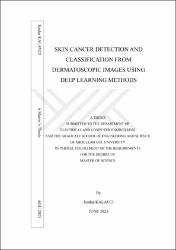| dc.contributor.author | Kalaycı, Serdar | |
| dc.date.accessioned | 2024-01-31T13:39:03Z | |
| dc.date.available | 2024-01-31T13:39:03Z | |
| dc.date.issued | 2023 | en_US |
| dc.date.submitted | 2023-06-08 | |
| dc.identifier.uri | https://hdl.handle.net/20.500.12573/1907 | |
| dc.description.abstract | Early detection of skin cancer is crucial for successful treatment and improved patient outcomes. The most prevalent form of cancer is skin cancer and if left undetected, it can spread and become more difficult to treat. A dangerous and frequently fatal type of skin cancer is melanoma. Regular skin examinations and self-examinations can help identify suspicious moles or lesions, which can then be evaluated by a dermatologist. In addition, advances in technology and artificial intelligence have enabled the development of tools for automated skin cancer screening, providing a convenient and efficient means of early detection. This can lead to more efficient diagnosis, reduced healthcare costs and improved patient care. By evaluating skin lesions from images, deep learning techniques have shown considerable potential in increasing the precision of melanoma detection. By using large datasets and complex neural networks, deep learning algorithms can effectively distinguish between benign and malignant skin lesions with high accuracy. Ensemble of CNN models helps improve the performance and reliability of the classification task. By combining the predictions of multiple CNN models lead to more accurate and robust predictions. In this thesis, for melanoma classification problem, many different data augmentations techniques applied and different convolutional neural networks architectures evaluated, applied vignetting effect filter and hair noise in accordance with the dataset and results of ensemble of the best CNN models are promising. This thesis attempts to produce a reliable model for the classification of melanoma by conducting experiments on two combined publically accessible data sets, ISIC 2019 and ISIC 2020. On the testing sets in our studies, the proposed solution attained 95.75% AUC. | en_US |
| dc.description.abstract | Cilt kanserinin erken teşhisi, başarılı tedavi ve daha iyi hasta sonuçları için çok önemlidir. Cilt kanseri en yaygın kanser türüdür ve tespit edilmezse yayılabilir ve tedavisi daha zor hale gelebilir. Melanom, cilt kanserinin ciddi ve genellikle ölümcül bir şeklidir. Düzenli cilt muayeneleri ve daha sonra bir dermatolog tarafından değerlendirilebilecek olan şüpheli benleri veya lezyonları belirlemeye yardımcı olabilir. Buna ek olarak, teknolojideki ve yapay zekadaki gelişmeler, otomatik cilt kanseri taraması için araçların geliştirilmesini mümkün kıldı ve erken teşhis için uygun ve etkili bir araç sağladı. Bu, daha verimli tanıya, daha düşük sağlık maliyetlerine ve daha iyi hasta bakımına yol açabilir. Derin öğrenme yöntemleri, görüntülerden cilt lezyonlarını analiz ederek melanom tespitinin doğruluğunu artırmada büyük umut vaat ediyor. Derin öğrenme algoritmaları, büyük veri kümelerini ve karmaşık sinir ağlarını kullanarak iyi huylu ve kötü huylu cilt lezyonlarını yüksek doğrulukla etkili bir şekilde ayırt edebilir. CNN modelleri topluluğu, sınıflandırma performansını ve güvenilirliğini artırmaya yardımcı olur. Birden fazla CNN modelinin tahminlerini birleştirilmesi daha doğru ve sağlam tahminlere yol açar. Bu tezde, melanom sınıflandırma problemi için birçok farklı veri artırma tekniği uygulanmış ve farklı evrişimli sinir ağları mimarileri değerlendirilmiş, veri setine uygun olarak uygulanan vinyet etkisi ve kıl gürültüsü ve en iyi CNN modellerinden oluşan topluluk sonuçları umut vericidir. Bu tez, halka açık iki veri seti olan ISIC 2019 ve ISIC 2020 üzerinde deneyler yaparak melanom sınıflandırması için sağlam bir model oluşturmayı amaçlamaktadır. Çalışmalarımızda, önerdiğimiz çözüm test setlerinde %95,75 doğruluk elde etti. | en_US |
| dc.language.iso | eng | en_US |
| dc.publisher | Abdullah Gül Üniversitesi / Fen Bilimleri Enstitüsü | en_US |
| dc.rights | info:eu-repo/semantics/openAccess | en_US |
| dc.subject | Deep Learning | en_US |
| dc.subject | Convolutional Neural Networks | en_US |
| dc.subject | Vignetting Effect | en_US |
| dc.subject | Hair Noise | en_US |
| dc.subject | Skin Cancer | en_US |
| dc.subject | Derin Öğrenme | en_US |
| dc.subject | Evrişimli Sinir Ağları | en_US |
| dc.subject | Vinyetting Etki | en_US |
| dc.subject | Kıl Gürültüsü | en_US |
| dc.subject | Cilt Kanseri | en_US |
| dc.title | Skin cancer detection and classification from dermatoscopic images using deep learning methods | en_US |
| dc.title.alternative | Derin öğrenme yöntemleri kullanarak dermatoskopik görüntülerden otomatik cilt kanseri tespiti ve sınıflandırılması | en_US |
| dc.type | masterThesis | en_US |
| dc.contributor.department | AGÜ, Fen Bilimleri Enstitüsü, Elektrik ve Bilgisayar Mühendisliği Ana Bilim Dalı | en_US |
| dc.relation.publicationcategory | Tez | en_US |


















